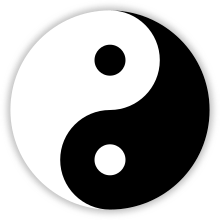

Yin and yang can be thought of as complementary (rather than opposing) forces that interact to form a dynamic system in which the whole is greater than the assembled parts. The term "dualistic-monism" or dialectical monism has been coined in an attempt to express this fruitful paradox of simultaneous unity and duality. The notion of duality can be found in many areas, such as Communities of Practice. This duality lies at the origins of many branches of classical Chinese science and philosophy, as well as being a primary guideline of traditional Chinese medicine, and a central principle of different forms of Chinese martial arts and exercise, such as baguazhang, taijiquan (t'ai chi), and qigong (Chi Kung), as well as appearing in the pages of the I Ching. Many natural dualities (such as light and dark, fire and water, expanding and contracting) are thought of as physical manifestations of the duality symbolized by yin and yang. It is believed that the organization of qi in this cosmology of Yin and Yang has formed many things. In the cosmology pertaining to Yin and Yang, the material energy, which this universe has created itself out of, is also referred to as qi. There are various dynamics in Chinese cosmology. Yin is the receptive and Yang the active principle, seen in all forms of change and difference such as the annual cycle (winter and summer), the landscape (north-facing shade and south-facing brightness), sexual coupling (female and male), the formation of both men and women as characters and sociopolitical history (disorder and order). In Chinese cosmology, the universe creates itself out of a primary chaos of material energy, organized into the cycles of Yin and Yang and formed into objects and lives. "dark-light", "negative-positive") is a Chinese philosophical concept that describes how obviously opposite or contrary forces may actually be complementary, interconnected, and interdependent in the natural world, and how they may give rise to each other as they interrelate to one another. Or go to printable activities that require research (using an atlas or other geography reference): a simple map research activity, a medium-level map research activity, or an advanced map research activity.In Ancient Chinese philosophy, yin and yang ( / j ɪ n/ and / j ɑː ŋ, j æ ŋ/ Chinese: 陰 陽 yīnyáng pronounced, lit. Or go to a blackline master (printout) of the flag of South KoreaĪ blackline master (printout) of the flag of South KoreaĪn outline map of South Korea to print. The Kwai trigrams are placed in such a way that they balance one another, heaven is placed opposite Earth, and fire is placed opposite water.Ī flag quiz/coloring printout of the South Korean flag. The four Kwae represent: heaven (three unbroken bars), the Earth (three broken bars), water (one unbroken line between two broken bars), and fire (one broken bar between two unbroken bars). The kwae trigrams are from the I Ching the broken bars symbolize yin (dark and cold) and the unbroken bars symbolize yang (bright and hot). Symbolically, the Yin-Yang symbol represents opposites it is the belief that all things in the universe have two, opposite aspects that cannot exist without the other. The white in this philosophical flag represents peace and purity. South Korea's flag was adopted on Januthe flag is called Taegukki (which means, "Great Extremes"). This ratio of the height to the width of the flag is 2:3.

Four groups of three long and short black bars (called kwae) surround the central circle. South Korea's flag pictures a red and blue Yin-Yang symbol, red (yang) on top, blue (yin) on the bottom, in the center of a white field. South Korea is a country in eastern Asia. Today's featured page: Multiplication Worksheets is a user-supported site.Īs a bonus, site members have access to a banner-ad-free version of the site, with print-friendly pages.


 0 kommentar(er)
0 kommentar(er)
